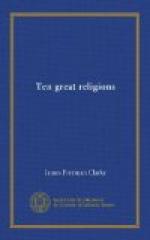to show that they are devoted to their neighbors.
The tonsure that they wear at the top of their heads
indicates that they have renounced worldly desires.
In giving liberty to slaves we become a link between
the powerful and weak. We do not accumulate
riches, and we share with the poor that which we possess.
Fasting strengthens the intellectual powers, abstinence
and moderation preserve health. We worship
seven times a day, and by our prayers we aid the
living and the dead. On the seventh day we offer
sacrifice, after having purified our hearts and
received absolution for our sins. This religion,
so perfect and so excellent, is difficult to name,
but it enlightens darkness by its brilliant precepts.
It is called the Luminous Religion.
5. Learning alone without sanctity
has no grandeur, sanctity without
learning makes no progress.
When learning and sanctity proceed
harmoniously, the universe is adorned
and resplendent.
The Emperor Tai-Tsoung illustrated the Empire. He opened the revolution, and governed men in holiness. In his time there was a man of high virtue named Olopen, who came from the kingdom of Ta-Thsin. Directed by the blue clouds, he bore the Scriptures of the true doctrine; he observed the rules of the winds, and traversed difficult and perilous countries
In the ninth year of Tching-Kouan (636) he arrived at Tehang-ngan. The Emperor ordered Fang-hi-wen-Ling, first minister of the Empire, to go with a great train of attendants to the western suburb, to meet the stranger and bring him to the palace. He had the Holy Scriptures translated in the Imperial library. The court listened to the doctrine, meditated on it profoundly, and understood the great unity of truth. A special edict was promulgated for its publication and diffusion.
In the twelfth year of Tching-Kouan,
in the seventh moon, during the
autumn, the new edict was promulgated
in these terms:—
The doctrine has no fixed name, the holy has no determinate substance; it institutes religions suitable to various countries, and carries men in crowds in its tracks. Olopen, a man of Ta-Thsin, and of a lofty virtue, bearing Scriptures and images, has come to offer them in the Supreme Court. After a minute examination of the spirit of this religion, it has been found to be excellent, mysterious, and pacific. The contemplation of its radical principle gives birth to perfection and fixes the will. It is exempt from verbosity; it considers only good results. It is useful to men, and consequently ought to be published under the whole extent of the heavens. I, therefore, command the magistrates to have a Ta-Thsin temple constructed in the quarter named T-ning of the Imperial city, and twenty-one religious men shall be installed therein.
* * * * *




